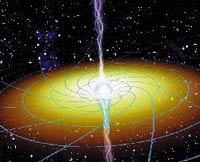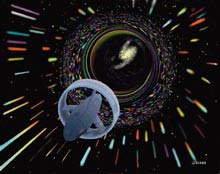If we are to get to
travel to distant regions of space and time then first we need to get to
grips with that most exotic of phenomena…the Black Hole…
Ever
since the beginning, gravity has been making our universe less and less
uniform and building up ever-larger contrasts of density and
temperature. In the end, gravity overwhelms all the other forces in
stars, and in anything larger, even though the effects of rotation and
nuclear energy delay its final victory.
There
are some entities in which gravity has already triumphed over all other
forces. These are black holes - objects that have collapsed so far that
no light or any other signal can escape them, but that nonetheless
leave imprints, distortions of space and time, frozen in the space
they've left.
An
Astronaut who ventured too close to a black hole would pass into a
region from which there is no return and from where no light signals can
be transmitted to the external world; it is as though space itself were
being sucked inward faster than light moves through it. An external
observer would never witness the falling astronaut's final fate: any
clock would appear to run slower and slower as it fell inward, into the
hole, so the astronaut would appear impaled at a horizon, frozen in
time.
The
Russian theorists Yakov Zeldovich and Igor Novikov, who studied how
time was distorted near collapsed objects, coined the term 'frozen star'
for such objects. Zeldovich, one of the last polymaths of physics,
holds a prominent place in modern cosmology. He was a dynamic and
charismatic personality; from the 1960s onward, his research school in
Moscow spearheaded many key discoveries (even though cosmology and
relativity had previously been ideologically tainted in the USSR). The
term 'black hole' itself was not coined until 1968, when John Wheeler
described how an infalling object 'becomes dimmer millisecond by
millisecond…light and particles incident from outside …go down the black
hole only to add to its mass and increase its gravitational
attraction."
 Artists impression of a Black Hole - Possibly as heavy as 2.6 million Suns! Artists impression of a Black Hole - Possibly as heavy as 2.6 million Suns! |
Black
holes, the most remarkable consequences of Einstein's theory, are not
just theoretical constructs. There are huge numbers of them in our
Galaxy and in every other galaxy, each being the remnant of a star and
weighing several times as much as the Sun. There are much larger ones,
too, in the centres of galaxies. Near our own galactic centre, stars are
orbiting ten times faster than their normal speeds within a galaxy.
They are feeling, close up, the gravity of a dark object, presumably a
black hole, as heavy as 2.6 million suns. Yet our Galaxy is poorly
endowed compared to some others, in whose centres lurk holes more
massive than a billion suns, betraying their presence by the high speed
motions of surrounding stars and gas, induced by their gravitational
pull.
Black
holes are among the most exotic entities in the cosmos. But they are
actually among the best understood. They are constructed from the fabric
of space itself and are as simple in structure as elementary particles.
A newly formed black hole quickly settles down to a standardised
stationary state characterised stationary state characterised by just
two numbers: those that measure its mass and its spin. (In principle,
electric charge is a third such number, but stars can never acquire
enough electric charge for this factor to be relevant to real collapse).
The distorted space and time around black holes is described exactly by
a solution of Einstein's general relativity equations that was first
discovered in 1963 by Roy Kerr, a mathematician who later forsook
research to become an internationally recognised bridge player. In
general, macroscopic objects seem more and more complicated as we view
them closer up, and we can't expect to explain their every detail; but
black holes are an exception to this rule.
Viewed
from outside, no traces remain that distinguish how a particular hole
formed, nor what kind of object it swallowed. The great Indian
astrophysicist Subrahmanyan Chandrasekhar was deeply impressed by this
realisation, aesthetically as well as scientifically: " In my entire
scientific life," he wrote, "the most shattering experience has been the
realisation that an exact solution of Einstein's equations of general
relativity, discovered by the New Zealand mathematician Roy Kerr,
provides the absolutely exact representation of untold numbers of
massive black holes that populate the Universe." Roger Penrose, the
theorist who perhaps did most of to stimulate the renaissance in
relativity theory that occurred in the 1960s, has remarked. "It is
ironic that the astrophysical object which is strangest and least
familiar, the black hole, should be the one for which our theoretical
picture is most complete". The discovery of black holes thus opened the
way to testing the most remarkable consequences of Einstein's theory.
Black
Holes interest astronomers because the flow patterns and magnetic
fields around them generate some of the most spectacular pyrotechnics in
the universe. But they challenge basic physics as well. Around any
black holes is a horizon, a surface shrouding from view an interior from
which not even light can escape. A hole's size is proportional to its
mass: if the sun became a black hole, its radius would be 3 kilometres,
but some of the supermassive holes in galactic centres are as big as our
whole solar system. If you fell inside one of these monster holes, you
would be treated to several hours of leisurely observation before you
approach the centre, where increasingly violent tidal forces would shred
you apart. Right at the centre, you, or your remains, would encounter
the singularity where the physics transcends what we yet understand. The
new physics that we'll need is the same that governs the initial
instants of the Big Bang.
Fast-Forward and Backward in Time?
Good
science fiction should respect the fundamental constraints of physical
law. In that sprit, it is worth mentioning that an observer could, in
principle, observe the far future in what, subjectively, seemed quiet a
short time. According to Einstein, the speed of a clock depends on where
you are and how you're moving. If your subjective clock ran very slowly
compared to the cosmic clock, you could travel "fast forward" into the
future. This would happen if you were moving at a velocity close to the
speed of light. Furthermore, strong gravity would distort time; clocks
on a neutron star would run 20 or 30 percent slower. Near a black hole,
the distortions would be even greater. If you were to fall into one,
your future would be finite; you would be ripped apart - spaghettified -
by ever more violent gravitational forces. However, a more prudent
astronaut who managed to get into the closest possible orbit around a
rapidly spinning hole without falling into it would also have
interesting experiences, space-time is so distorted there that his clock
would run arbitrarily slow and he could, therefore, in a subjectively
short period, view an immensely long future timespan in the external
universe.
This elasticity in the rate
of passage of time may seem counter to our intuition. But such
intuition is acquired from our everyday environment (and perhaps, even
more, that of our remote ancestors), which has offered us no experience
of such effects. Few of us have travelled faster than a millionth of the
speed of light (the speed of a jet airliner); we live on a planet where
the pull of gravity is 1000 billion times weaker than on a neutron
star. But time dilation entails no inconsistency or paradox.
More
problematic, of course, would be time travel back into the past. More
than fifty years ago, the great logician Kurt Godel discovered that the
theory of general relativity did not in itself preclude a time machine.
He discovered a valid solution of Einstein's equations that described a
bizarre universe where some of the worldlines were close loops - in
other words, you could come back into your own past. But Godel's
solution was not realistic: it described a universe that was rotating
and not expanding.
Other theoretical
examples of systems that seem to obey the laws of physics but which
allow closed loops in time have been proposed. For example, Princeton
theorist Richard Gott showed that a time machine could be constructed
from two so called cosmic strings - long microscopically thin tubes of
hyperdense material, heavy enough to distort space. Gott and his
colleague Li-Xin Li also devised a cosmological model even stranger than
Godel's in which an entire universe, with a finite life cycle, traces
out a loop in time so that its end is also its beginning.
One
much-discussed design for a time machine involves a "wormhole": two
black holes linked together by a tunnel or "spacewarp". The tunnel could
exist only if it were made of a substance that has very large negative
pressure (or tension). Theorists speculate that exotic stuff of this
kind did exist in the early universe, but even if such material still
existed, the mass needed in order to make a wormhole wide enough to be
comfortably traversed by a human would be 10,000 times that of the Sun!
 Wormhole Travel? Wormhole Travel? |
Godel's
discovery and its aftermath opened up a debate. Is there a future law
of physics, more restrictive than Einstein's equations that rule out
such effects? One might call it a "chronology protection law". Or could a
time machine in principle exist? Such an artefact plainly still lies in
the hypothetical reaches of science fiction, but we can still ask
whether the barriers to constructing a time machine are merely
technological, or whether there is a fundamental physical law that
prohibit them. (To clarify the distinction, most physicists would say
that a large spaceship travelling at 99.99 percent of the speed of light
is in the first category, but one that travels faster than light is in
the second.)
The
events on the time loop must close up self-consistently, as in a movie
whose last scene recapitulates its first. Paradoxes arise if you come
back into the past and undo something that was a precondition of your
existence: for instance, murdering your grandmother in her cradle would
raise issues of logical consistency, not just of ethics. Time travel
makes sense only if some law of nature precludes inconsistency of this
kind. The implication that there must be "time police" to constrain our
free will might seem paradoxical. But I am convinced by the robust
retort of Igor Novikov, a leading physicist who has explored these
ideas, that physical laws already constrain our choices: we cannot, for
instance, exercise our free will by walking on the ceiling. The
prohibition on violating the consistency of a time loop is, in a sense,
analogous.
Even if a time machine
could be built, it would not enable us to travel back prior to the date
of its construction. So the fact that we have not been invaded by
tourists from the future may tell us only that no time machine has yet
been made, not that it is impossible.

















